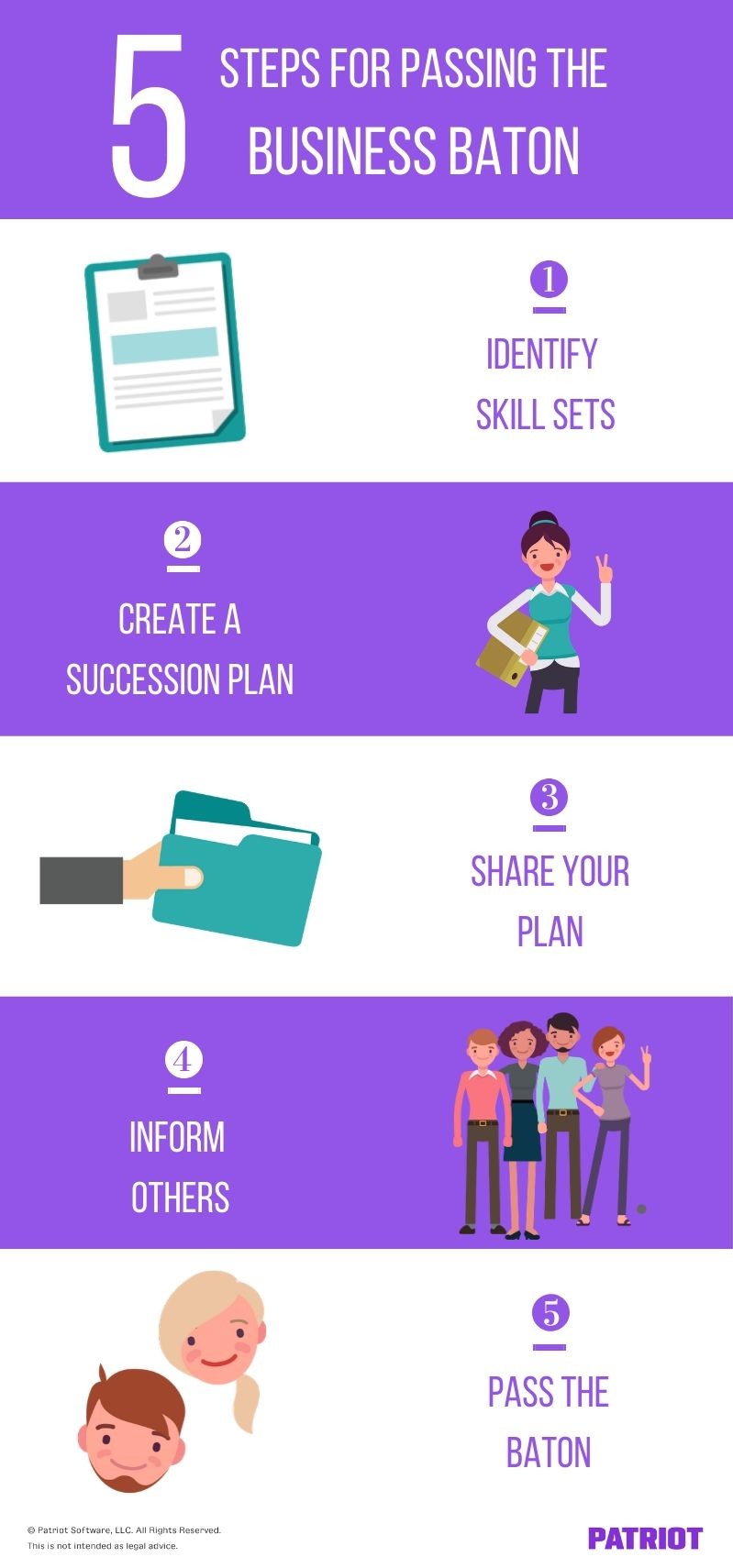Whether you’re planning on passing the business baton to one of your family members, employees, or an external expert, you need to prepare your business for the future.
According to one source, 40% of businesses face issues when it comes to succession. Instead of hitting a bunch of succession roadblocks and putting your company’s success in jeopardy, create a solid business succession plan.
Your business succession plan is your roadmap to success. Are you ready to put the “success” in business succession?
5 Steps to pass the baton and move on
You have a few options when it comes to business succession. You might sell your company. Or, you might pass down ownership or find a successor, such as a family member or employee.
If you want to smoothly transition out of your business, you need to know what steps to take. Use these five steps to set your business up for success in the future.

1. Identify necessary skill sets
If you’re planning on letting someone take over your business, you need to know who qualifies for what roles. There’s nothing worse than putting someone in a leadership or management position when they’re not ready to take that plunge.
Look at each role that is going to be affected when you pass the baton. Is it just your role? Or, will it be multiple roles?
Make a list of the positions that your succession plan will impact. Then, go through and think about what qualifications and skill set each role will need to survive in the future.
When you think about filling each role, consider whether your successors will be internal, external, or both. You might even consider hiring family members to fill certain roles.
Look at each of your employees and determine whether or not they are qualified for the upcoming available roles. Naming an existing employee as a successor has a lot of perks. Your employees are already familiar with and (hopefully) comfortable with them. Not to mention, a current employee would already know your business’s mission and future goals.
If you plan on hiring externally, be sure to take your time to find the right fit for your business. Keep in mind that your succession plan might change up a bit if you hire someone from outside the business (e.g., different training).
2. Create a succession plan
Your succession plan can easily make or break your company’s future success. Done right, you’ll be able to pass the baton seamlessly. Done wrong, your business could wind up in bad hands.
So, what kind of bases should your succession plan cover? To protect the fate of your small business, your succession plan should do the following:
- Establish a clear direction
- Help maintain brand identity
- Develop training for teamwork and leadership
- Narrow down key players (e.g., managers)
- Identify future leaders
- Select new owners and stockholders, if applicable
- Pick a new CEO, if applicable
In your plan, determine what will be best for your company. Ask yourself questions like, Do I want my plan to only cover upper-level management? What kind of vulnerabilities does my business have? What is my ultimate goal for the business?
The more questions you ask yourself, the better off your business will be. Take time to really think about what you want to cover in your plan. After all, your business’s future is counting on it.
Make your plan as detailed as possible. That way, your business can smoothly transition when you leave the business.
3. Share your plan with potential successors
Once you narrow down who you would like to take over each role and become a successor, you need to spread the news to people who will potentially be involved in the plan. This step in the process can vary depending on whether you’re looking internally or externally.
If you’re looking to have one of your current employees become a future successor, remember that they might turn down the opportunity.
If you’re planning to hire someone externally for the role, make sure you’re upfront with them during the interview process. Be as honest as possible about the position, the business, and your expectations.
After you create your solid succession plan and hand pick possible successors, inform each individual of your decision. Be open, honest, and transparent when discussing the opportunity with the successors. It’s best not to sugar coat anything. That way, your potential successors know what to expect for the future.
Explain to each potential successor why you see them as a good fit for the role. And, let them know what the future role entails.
Remember, you’re trying to fill big shoes. And, the responsibility of taking over a big role might not be everyone’s cup of tea. Be prepared for questions as well as rejections.
4. Inform family, employees, and customers
After you determine who will fill each role and decide that it’s time to step down, inform your company. This includes anyone affected by your succession plan, including both your employees and customers.
When informing employees, consider making it a little more formal with a meeting. You can even have a little question and answer session to address the succession and transition.
You can also send out a formal announcement to your customers. Just like your employees, it’s important to be transparent with your customers about the transition, too. That way, they can rest assured that your business is in good hands going forward. Consider sending out a mass email to your customers or publishing a press release.
If you work closely with other businesses or have vendors you work with, inform them of the change, too.
5. Pass the baton!
Congratulations! It’s time to pass your business baton. After you build your succession plan, discuss options, get your business on board, and inform everyone, you can say you’ve officially passed your business onto the next generation.
If you’re not ready to completely move on from your business, find ways to still be active at your company without stepping on any toes. For example, if you want to participate in some aspects of your business but not own or run it, you might decide to become a board member or chairperson.
4 Tips for passing the torch
Ready to pass the torch at your small business? Great! Be sure to follow the four tips below to make sure the transition is quick and painless.
1. Have candid communication
If you’re planning on passing the baton to another employee or new hire, have clear communication with everyone involved. If someone is left out of the loop, it can leave room for problems down the road with training and other plans for succession.
Make sure you’re as candid as possible with your employees, potential successors, vendors, and customers. The more open you are with everyone, the better your transition will be.
2. Don’t be afraid to ask for help
Business succession planning is a lot of work. There are a ton of things that go into it that you might not think of during the planning process.
When it comes to passing the baton to the next generation, don’t be afraid to ask for help. In most cases, you can’t pass the baton by yourself.
Consider seeking help from a professional, such as a small business lawyer or CPA. That way, you are as thorough as possible and don’t have to go at the succession process alone.
3. Encourage the next generation
Positivity is key when it comes to passing down your business. If your staff isn’t on board, then who will support your business when you’re gone?
When you plan on leaving your business, reassure your employees that everything is going to be alright.
Remember that your employees look up to you. And, they’re going to look at you as a role model during the succession process. So, bring on your positivity vibes and show employees that change can be a good thing.
4. Plan as much as you can
When it comes to planning your succession, sooner is always better than later. Your succession plan and strategy are not something you want to procrastinate on.
Be proactive with your small business succession planning. Don’t wait until the last minute to start thinking about how you will leave your company behind.
If you start planning ahead of time, your business, employees, and customers will thank you later.
